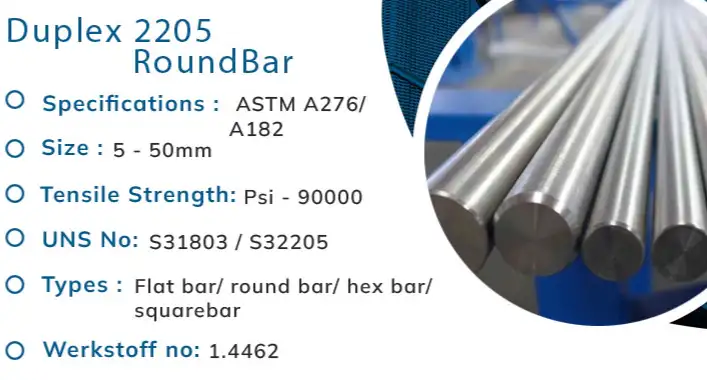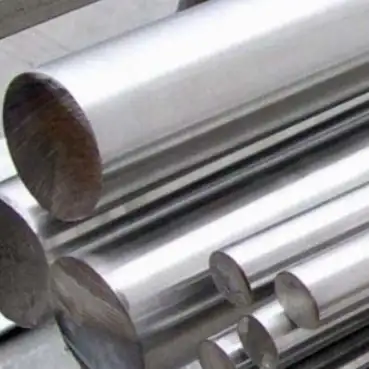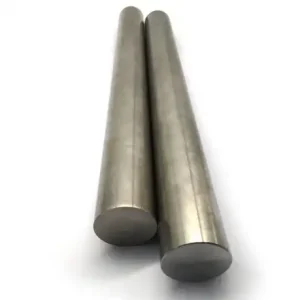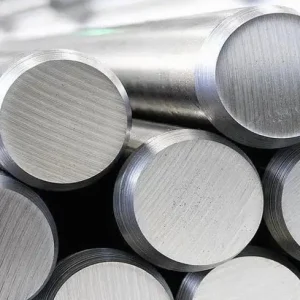Alloy 2205 duplex bar (UNS S32205 / S31803, EN 1.4462) is the market standard when you need a stainless-steel bar that combines significantly higher strength than 300/316 grades with far better resistance to chloride pitting and stress-corrosion cracking. For most oil & gas, chemical, desalination and seawater-exposed structural uses where weight, section thickness, and localized corrosion resistance matter, 2205 offers an excellent balance of cost and performance. For buyers who need factory-direct supply from China with fast stock delivery and competitive pricing, MWAlloys supplies 2205 duplex bars at 100% factory price with ready inventory and export support.
What is Alloy 2205
Alloy 2205 is a duplex stainless steel (a roughly equal mixture of austenite and ferrite phases) that was developed to outperform 300-series and 316/317 stainless steels in chloride environments while providing much higher mechanical strength. Its composition emphasizes chromium, molybdenum and nitrogen additions to raise pitting resistance and stress-corrosion cracking resistance relative to conventional austenitic alloys. It is widely available in bar, plate and pipe forms for pressure-containing and structural components.
Chemical composition and metallurgical structure
Typical composition ranges (representative for UNS S32205 / 2205):
| Element | Typical range (wt%) |
|---|---|
| Chromium (Cr) | 21.0 – 23.0 |
| Nickel (Ni) | 4.5 – 6.5 |
| Molybdenum (Mo) | 2.5 – 3.5 |
| Nitrogen (N) | 0.08 – 0.20 |
| Carbon (C) | ≤ 0.03 |
| Manganese (Mn) | ≤ 2.0 |
| Silicon (Si) | ≤ 1.0 |
| Phosphorus (P) / Sulfur (S) | very low (trace limits) |
The duplex microstructure — roughly 50/50 ferrite and austenite in the annealed state — delivers the combination of high yield strength and improved localized corrosion resistance. Nitrogen contributes strongly to strengthening and pitting resistance without the large nickel premiums required by austenitic grades. Typical composition bands and guidance are documented in widely used datasheets and manufacturer technical notes.
Why that mix matters:
-
Chromium provides general corrosion and passivity.
-
Molybdenum increases pitting and crevice resistance.
-
Nitrogen raises both mechanical strength and pitting resistance (PREN).
-
Lower nickel reduces cost versus high-nickel austenitics while retaining toughness.

Mechanical properties
Values depend on heat treatment, bar diameter and finish, but typical annealed (as-supplied) bar properties are:
-
Tensile strength (ultimate): ~ 620 MPa (≈ 90 ksi) minimum.
-
Yield strength (0.2% offset): ~ 450–500 MPa (≈ 65–72 ksi) minimum.
-
Elongation: ≥ 25% (50 mm gauge typical).
-
Hardness (HB): typically ≤ 290 HB as-supplied.
These mechanical characteristics generally give ~2× yield strength of 304/316 stainless steel, enabling thinner sections or lighter components for equivalent load conditions. When strength matters (pressure piping, shafts, fasteners, valves), 2205 can be a cost-effective material of choice because lower section weight offsets higher material unit cost.
Corrosion resistance and PREN
Pitting Resistance Equivalent Number (PREN) is commonly used to quantify resistance to localized corrosion (pitting/crevice) in chloride-containing environments. Simplified PREN formula:
PREN = %Cr + 3.3 × %Mo + 16 × %N (variations exist).
For typical 2205 chemistries the PREN sits in the high-20s to mid-30s depending on exact alloy chemistry — high enough for many seawater, offshore and chemical processing environments but below “super-duplex” grades whose PREN typically exceeds 38–40. That means 2205 is frequently chosen where the environment is aggressive but not extreme (e.g., many subsea and process plant services).
Stress corrosion cracking (SCC):
Because of the ferritic phase and higher chromium/nitrogen, duplex 2205 is markedly more resistant to chloride SCC than 304/316 austenitic stainless steels. That property makes 2205 highly attractive for oil & gas piping, heat exchangers, and flue gas desulfurization components.
Standards, designations and common specifications
2205 appears under multiple international identifiers — always request the exact designation you need in purchase orders and mill certificates:
-
UNS: S32205 (and closely related S31803; S32205 is the more tightly controlled composition).
-
EN / DIN: 1.4462 (X2CrNiMoN22-5-3).
-
ASTM / ASME: used in A276 (bars), A240 (plate) and A182 (forgings/fittings) variants — check the exact ASTM spec referenced on the order (e.g., A276 UNS S32205 for bars).
Why this matters: different specifications control composition tolerances, testing (e.g., tensile, hardness), non-destructive examinations and mill testing requirements. When procuring bar stock for pressure parts, always specify the standard (mill test report grade) and the required heat treatment state.
Fabrication, welding and heat treatment guidance
Weldability: 2205 is weldable but requires controlled procedures to maintain duplex balance and avoid deleterious phases:
-
Use matched composition filler where possible (e.g., 2209/2205-matching fillers for higher PREN).
-
Preheat is generally not required; typical practice is to keep interpass temperatures low and avoid excessive heat input.
-
Post-weld heat treatment is rarely used for standard 2205; instead, use controlled welding procedures to preserve a roughly 50/50 microstructure in the weld and HAZ.
-
Avoid overheating and long holds in 300–1000°C range that can form sigma and chi phases, which reduce toughness and corrosion resistance.
Forming and cold working: Duplex steels work-harden faster than austenitics due to the ferrite phase. Form gradually; if large deformation is needed, solution annealing followed by controlled cooling may be required.
Heat limits: Avoid permanent service above ~300°C for extended times (some references give 280–600°F (≈150–315°C) caution ranges) because long exposure can cause embrittlement from sigma-phase formation and ferrite ageing (475°C embrittlement phenomena).
Typical applications and why 2205 is chosen
Common applications where 2205 bars are used:
-
Valve stems, shafts and fasteners for subsea and topside equipment.
-
Pump shafts and impellers in seawater systems.
-
Heat exchanger tubes and tube sheets in chemical plants.
-
Flanges, couplings and fittings in desulination and offshore oil & gas.
-
Structural components exposed to brackish or marine atmospheres (bridges, coastal infrastructure).
Why it’s chosen: higher strength reduces section size; improved localized corrosion resistance increases component lifetime in chloride environments; lower nickel than 300-series helps control material cost when nickel prices are high.
Procurement, quality assurance and MWAlloys supply advantages
When specifying 2205 bars for critical service, insist on:
-
Mill Test Reports (MTRs) with chemical and mechanical test results traceable to the lot/heat number.
-
Heat treatment and hardness records and any NDT required by your project (UT, PMI or eddy current as applicable).
-
Certifications: ISO 9001 and (if needed) PED/ASME certification for pressure applications.
-
Material traceability: full heat-to-part chain.
MWAlloys offer (practical selling points):
-
We are a China-based manufacturer and stocker of duplex 2205 bar in a range of diameters and finishes. MWAlloys supplies 100% factory-priced material (no trader mark-ups), provides fast stock delivery for common sizes, and issues full mill certificates and inspection documentation on every shipment. Our export team supports documentation (COO, MTRs, third-party inspection on request) to meet construction and procurement compliance. For clients who need short lead times, our local stock and production scheduling reduce procurement risk compared to long international waits. (Supplier examples and comparable Chinese mills are widely listed on global trade portals; verify by requesting MTR and visiting the factory or third-party inspection for large projects).
Global price comparison 2025
Important note on pricing: duplex 2205 is a specialty stainless alloy; its unit price varies substantially with global nickel and molybdenum markets, form (bar vs plate vs forgings), quantity, mill/brand, and processing (forged, solution-annealed, cold-finished). The table below gives representative retail/factory ranges observed in 2025 marketplaces and sourcing portals — use these as directional guides only. Always request firm quotes with Incoterms and minimum order quantity (MOQ).
| Region / Channel | Representative 2025 price per kg (USD) | Notes / source |
|---|---|---|
| China — factory / Alibaba listings | $1.5 – $4.0 / kg (small retail lots) | Supplier listings show very low retail prices for small lots; verify composition & MTR. |
| China — factory (reliable mills, stock bar) | $4.5 – $9.0 / kg | Factory direct for qualified mills with MTRs; depends on diameter and finish. |
| India / local distributors (retail) | $3.5 – $8.0 / kg | Regional distributor pricing; import duties and GST vary. |
| Europe (distributor / stock) | $6.0 – $12.0 / kg | Higher due to labor, processing and distribution margins. |
| North America (distributor) | $8.0 – $16.0 / kg | Includes distributor margin and compliance documentation; brand and origin matter. |
Interpretation & buying tips:
-
Extremely low retail listings (e.g., <$3/kg) often reflect small-lot sellers, uncertain MTRs, or pricing per specified packaging unit — always confirm the UNS grade (S32205 vs S31803), heat treatment, MTR and whether the product is duplex 2205 certified and not generic “2205-like.”
-
For critical service (pressure, subsea, chemical), pay premiums to obtain verified S32205 material with full MTR, PMI checks and (if required) third-party test reports. Cheap parts without traceability are a false economy.
Machining, cold forming and finishing notes
-
Machining: 2205 is tougher than austenitics; tool selection and feeds should account for higher strength. Carbide tooling, positive rake geometry and good coolant are recommended for bar turning and milling. Expect faster tool wear than 316.
-
Cold forming: work-hardening is more pronounced; consider intermediate anneals for deep drawing or heavy bending.
-
Surface finish: applications in seawater or food contact may require specific surface finishes (e.g., 2B, polished, passivation) and post-fabrication cleaning to remove surface iron contamination. Passivation with nitric or citric acid processes improves barrier layer uniformity.
Storage, traceability and what to request from suppliers
When taking delivery of 2205 bars, ensure:
-
Bars are tagged with heat number and mill identity.
-
MTRs accompany the shipment and match the heat number of the material delivered.
-
Packaging protects ends and surfaces from contamination (oil coatings, plastic sleeving).
-
PMI or spectro analysis on receipt is acceptable for spot checks; for critical orders, arrange third-party inspection or witness testing at the mill. MWAlloys can arrange third-party inspection on request.
Sustainability, recycling and lifecycle notes
Duplex stainless steels are highly recyclable; scrap streams from production and end-of-life recycling recover chromium, nickel and molybdenum efficiently. Selecting duplex can reduce lifecycle CO₂ and material intensity in weight-sensitive designs (because thinner sections are possible). However, higher alloy content means initial embodied energy and raw material footprint may be higher than low-alloy steels — lifecycle assessments should be project-specific.
Risk factors, common failure modes and mitigation
-
Improper welding (excessive heat input) → formation of sigma phase → reduced toughness and corrosion resistance. Mitigation: qualified welding procedures and appropriate filler metals.
-
Temperature embrittlement from prolonged exposure in mid-temperature range (≈ 250–600°C): avoid long service at these temperatures or choose alternate alloys.
-
Incorrect grade or undocumented material: buying non-certified material is a common procurement risk; always require MTRs and, for safety-critical parts, independent inspection.
FAQs
-
Q: Is 2205 better than 316L for seawater service?
A: For many seawater and chloride-rich services, yes — 2205 typically has better pitting and SCC resistance than 316/316L and higher strength; but for extreme deepwater or very high chloride concentrations, super-duplex grades may be required. -
Q: What is the difference between UNS S31803 and S32205?
A: S32205 is a tighter chemistry variant (especially for nitrogen) and is commonly specified for higher PREN and improved corrosion resistance; S31803 is the earlier designation. Ask suppliers which UNS standard the MTR references. -
Q: Can I weld 2205 with 316 filler?
A: Not recommended. Use filler designed for duplex metallurgy (e.g., 2209) to retain required duplex balance and corrosion resistance. -
Q: What inspection documents should I require?
A: MTR (EN 10204/3.1 or 3.2 where required), PMI/chemical analysis, tensile and hardness test records, and third-party inspection if critical. -
Q: Typical lead time from Chinese mills?
A: For stocked sizes MWAlloys can ship quickly (days to weeks); for large, non-stocked heats, lead times depend on mill capacity (commonly 3–8 weeks). Always confirm stock status and shipping terms. -
Q: Is 2205 magnetic?
A: Duplex steels have ferrite and therefore can show magnetic response (more than austenitic 316). Magnetic response varies with cold work and heat treatment. -
Q: What temperature limits apply?
A: For long service life, avoid continuous service above ≈ 300°C (risk of intermetallic phase formation and embrittlement). -
Q: How does cost compare to 316L?
A: Per-kg cost is typically higher than 316L, but greater strength often reduces part mass — a net life-cycle or first-cost tradeoff depending on application. See price comparison for 2025 ranges above. -
Q: Can 2205 be hardened by heat treatment?
A: No conventional quench-hardening used; duplex strength comes from microstructure and alloying. Solution annealing is used to restore duplex balance after hot work. -
Q: How to maintain corrosion resistance after fabrication?
A: Clean weld spatter, pickling/passivation where needed, and maintain surface finish; use passivation procedures recommended for duplex grades.
Practical selection checklist
-
Confirm exact UNS/EN/ASTM designation on PO.
-
Request MTR (EN 10204 3.1/3.2 as required).
-
Specify required diameters, tolerances, straightness and finish.
-
Specify welding filler metal if welds are part of scope.
-
Decide on NDE (PMI, UT) and third-party inspection if necessary.
-
Ask for stock vs mill order lead time and choose supplier accordingly — MWAlloys offers fast dispatch for common sizes from stock.





